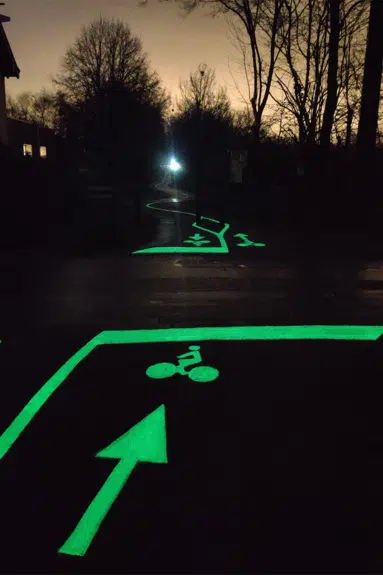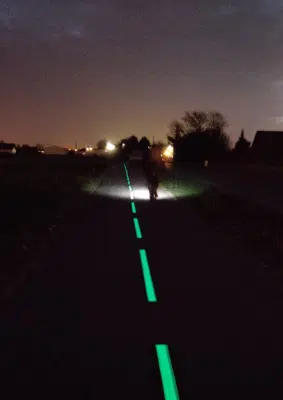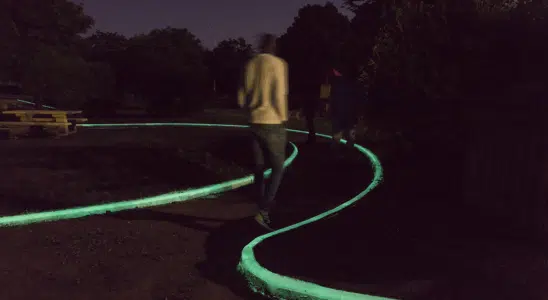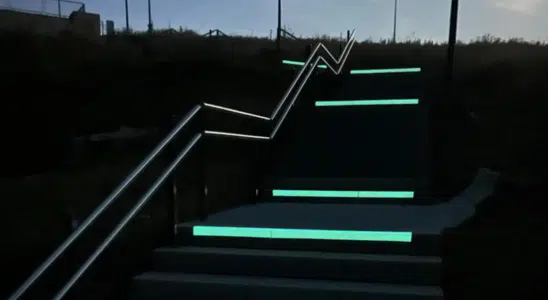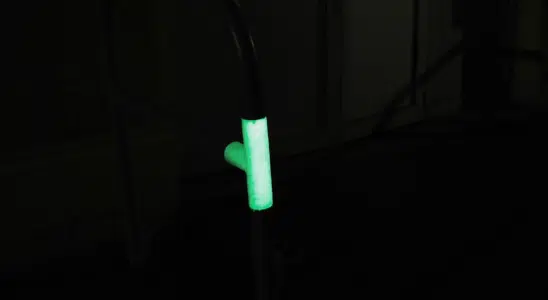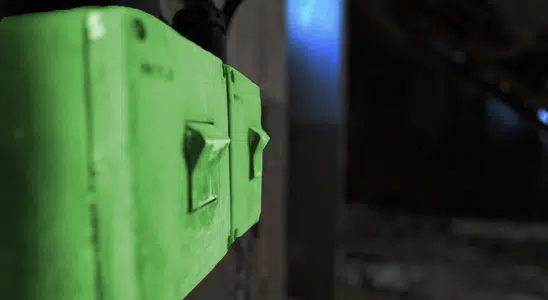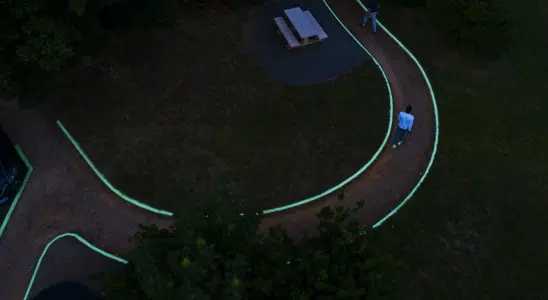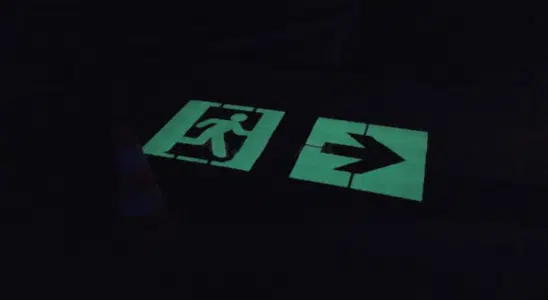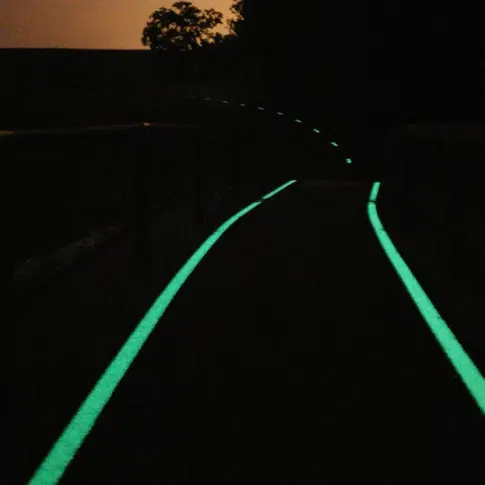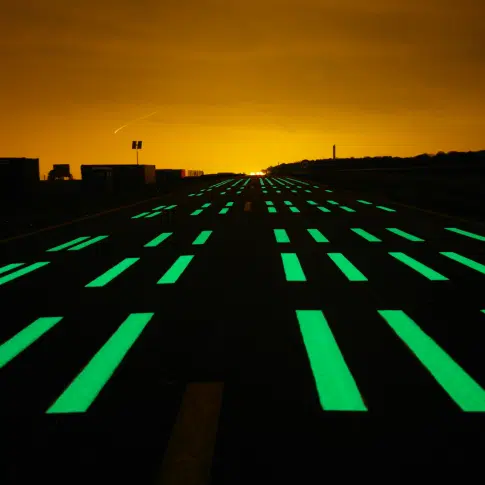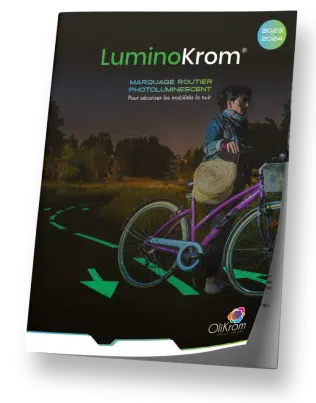Photoluminescence, visibility and safety
Night-time visibility, a necessity for user safety
During the day, the light emitted by the sun allows us to see, to situate ourselves in space, to navigate, to avoid obstacles and to recognize each other. When it's dark, the risk of accidents increases considerably due to poor visibility.
To compensate for this difficulty of visibility and guide ourselves in the dark, man first used fire (torches, candles, candelabras, etc.), then discovered electricity and invented the light bulb.
Today, LuminoKrom® paint represents a major technological advance in the field of night-time visibility. Thanks to its photoluminescent properties, this intelligent paint offers a self-contained, durable solution for improving visibility and safety in environments with little or no lighting.
Why are risks greater at night?
Diminished visual perception: human vision is naturally less effective at night, even with the lights on a bicycle or a pedestrian's headlamp. Objects, obstacles and road markings are harder to spot, which can lead to errors of judgment. Road users see their vision diminish and their orientation is affected.
Longer reaction times: with reduced visibility, road users need more time to react to events, whether it's a pedestrian crossing the road, or a cyclist approaching a dangerous bend or creek bank. In the dark, spatial perception is disrupted and the distinction of surrounding elements is drastically impacted.
Fatigue and distractions: Night-time travel is often associated with increased fatigue, which reduces users' vigilance. Clear, optimized visibility compensates for this lack of attention by making hazards more obvious.
What are the differences between
photoluminescent paint and conventional road markings?
LuminoKrom® outperforms conventional paints in terms of visibility thanks to its ability to glow in the dark, reducing dependence on artificial lighting. Conventional paint has no ability to emit light. Conventional road markings use paints mixed with glass microbeads or other reflective materials that reflect the light of vehicle headlights back to drivers, making the marking visible at night.
In the absence of available light in the environment (lighthouse), conventional paint is totally ineffective. Marking becomes invisible in low-light conditions or in total darkness.
In the case of LuminoKrom® marking products, the emission of luminescence improves night-time visibility, particularly in environments with no or insufficient street lighting. Luminescent road markings become luminous guides in the dark. This helps to orientate users, prevent accidents and provide reassurance, as night-time is still a source of anxiety for many citizens.
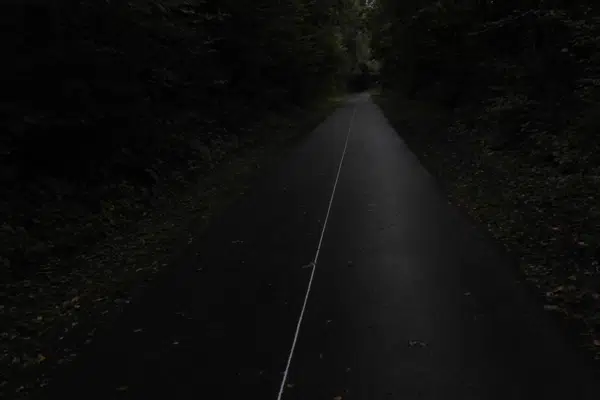
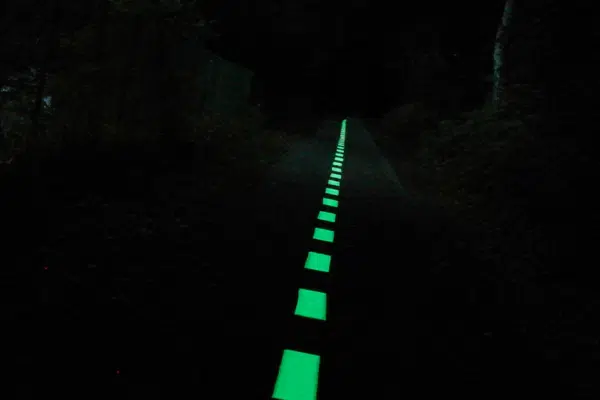
Reduced visibility and adverse weather conditions
In fog, heavy rain, snow or storms, visibility can be severely reduced, making it difficult to see roads, sidewalks, kerbs or essential objects such as pictograms on the ground (directional arrows, indications on the pavement layout...). Conventional light sources, such as headlights or street lamps, can be reflected or scattered by water particles, creating glare and reducing light efficiency.
LuminoKrom® operation in low-visibility conditions
- No glare: unlike artificial lights, LuminoKrom® does not produce reflections or glare in damp or foggy conditions. The light emitted is soft and uniform, enhancing the perception of visual cues without interfering with vision.
- Charging by natural or artificial light: The paint recharges with daylight or artificial lamps, and continues to shine even in darkness or thick clouds. This ensures that markings remain visible for several hours in poor weather conditions.
- Increased visibility at night and in bad weather: LuminoKrom® photoluminescent emissions, often in green or yellow, are high-visibility colors even in pouring rain or foggy conditions, where most colors become more difficult to discern.
Types of applications in outdoor environments
with adverse weather conditions
Floor markings
LuminoKrom® can be applied to roads, sidewalks, bike paths and pedestrian areas to provide continuous visibility in poor lighting conditions. For example, photoluminescent road markings remain visible in dense fog or rain, helping users to find their way around.
Hazardous area signs
In high-risk environments considered accident-prone, such as sharp bends, bridges or flood zones, photoluminescent strips can be used to alert users and help them navigate safely, even in poor weather and low light conditions.
Infrastructure safety
Exterior staircases, handrails and posts can be painted with LuminoKrom® luminescent paint to remain visible in snow or rain. This helps to prevent falls and accidents due to poorly visible slippery surfaces, and thus makes travel safer for vulnerable users.
Use in industrial environments
In industrial sites, ports, or logistics areas where workers are exposed to the elements, LuminoKrom® can be used to mark safety zones, crosswalks, or equipment, ensuring better visibility in adverse weather conditions.
Logistics support
LuminoKrom® is the perfect partner for industrial environments dedicated to logistics and warehousing. In dense fog, luminous ground markings can guide transport vehicles, forklifts or pedestrians, reducing the risk of accidents.
Evacuation and rescue systems
In areas at risk from natural hazards or in the event of climatic crises (floods, storms, etc.), photoluminescent markings can help guide people to evacuation zones or emergency exits, even in the event of power cuts or extreme conditions, making users safer.
Night perception is affected by several factors, including the physiology of the human eye and lighting conditions. For the elderly, this becomes even more complex as eyes age and visual capacity declines.
- Diminished visual acuity: With age, the ability to see clearly in low-light conditions diminishes.
- Difficulty adapting to darkness: It becomes more difficult for the eyes to adapt quickly to changes in light, making it harder to make the transition from well-lit environments to dark areas.
- Glare sensitivity: Older people are more sensitive to glare, making it difficult to see when confronted with bright lights in a dark environment.
Lire la suite
Older people's difficulty distinguishing colors
- Eye physiology and night-time color perception: The human eye has two types of photoreceptor cells: cones, which are responsible for color vision and work best in bright light; and rods, which are more sensitive to dim light and are primarily responsible for night vision, but do not perceive color. That's why night vision is mainly shades of gray.
- Difficulty distinguishing colors: In the elderly, cone sensitivity diminishes, reducing the ability to perceive colors, especially in low-light conditions. In addition, the eye's crystalline lens turns yellow over time, which can impair color perception.
- The most visible night colors: Ultimately, the colors best perceived in low-light conditions are green and yellow. This explains why these colors are often used in night-time signage, such as road markings or safety signs. Red, on the other hand, is less visible at night. This explains why safety or warning systems rarely use red alone in dark environments.
LuminoKrom® for the elderly
For the elderly, the use of photoluminescent paints like LuminoKrom® offers several advantages in terms of safety and accessibility:
- Improved visibility: Given the difficulty elderly people have in seeing in low light conditions, luminescent paints capable of emitting green light at night are the most easily perceived spectrum. Retirement homes and homes for the elderly can benefit from the use of LuminoKrom® to make night-time movements safer.
- Safety and orientation: In care facilities or retirement homes, these luminescent paints can guide residents, for example, by clearly indicating exits or corridors, even in the event of a power failure.
- Reduced anxiety: Better visibility at night can also reassure the elderly, especially those with cognitive disorders or anxiety, as they feel safer in their environment.
- Better night-time visibility despite cataracts: People with cataracts have particularly impaired vision in low-light conditions, and their sensitivity to glare can exacerbate this problem. Photoluminescent paints such as LuminoKrom®, which emit a soft, diffused light, provide a glare-free visibility solution.
Réduire
Types of luminescent markings
Psychological benefits
Reduced nocturnal anxiety
The continuous visibility provided by LuminoKrom® can reduce the anxiety of present people who fear moving around in the dark. This gives them a sense of security and control over their environment, especially at night.
Peaceful environment
The soft lighting provided by LuminoKrom® luminescent paints creates a less aggressive and more comfortable environment for people, compared with artificial light sources which can be disruptive.
Learn all about the principle of photoluminescence
Universal visibility and safety
LuminoKrom®, as a photoluminescent technology, offers solutions for universal safety, meeting a variety of needs in many sectors, from road safety to industrial and residential infrastructures. This intelligent paint glows in the dark after absorbing light without the need for external energy.
Universal accessibility, territorial equality
LuminoKrom® extends modern safety standards to all areas, whether urban or rural. This is in line with a vision of territorial equality, where every citizen, regardless of location, can benefit from secure, modern infrastructures.
Rural and suburban areas suffer from a lack of street lighting, which increases the risk of accidents at night for pedestrians, cyclists and drivers alike. LuminoKrom® , by providing night-time visibility without the need for a power supply, makes it possible to offer an equivalent level of safety everywhere, without distinction between geographical areas.
By reducing the disparities between regions in terms of road safety and infrastructure, LuminoKrom® is part of an inclusive approach, where each territory benefits from the same technological advances in safety, while respecting the environment and budgetary constraints.
A universal solution for power blackouts
LuminoKrom® offers a major strategic advantage in situations of electrical black-out or shut-down, where the sudden and prolonged absence of street lighting can lead to increased safety risks.
Thanks to its photoluminescent properties, LuminoKrom® ensures autonomous, continuous visibility for over 10 hours, even in the event of a total power cut. Autonomous signage solutions like LuminoKrom® help reduce infrastructure dependence on artificial lighting, increasing resilience and safety.
In certain high-risk industrial environments, the concept of electrical shutdown may be voluntary, to compensate for an imminent explosion: gas or fuel leakage, high dust levels, etc. .... In such conditions, the safety of workers and infrastructures is crucial. The stakes are many: evacuation, business continuity planning in degraded modes... Autonomous signage solutions such as LuminoKrom® , which emit a light guide for 10 hours, are highly effective in improving visibility and facilitating evacuation in emergencies and/or long-term interventions.
our brochure
Discover technical details and application tips for our products in the official LuminoKrom® brochure.
"*" indicates required fields
Types of use in industrial environments
- Hazardous area marking: In industrial environments (factories, warehouses, production sites), LuminoKrom® can be used to mark hazardous areas, traffic routes or sensitive equipment. Workers can see these markings, even in low light or during power cuts.
- Evacuation routes and emergency exits: In the event of a power cut or emergency, photoluminescent markings applied to evacuation routes and emergency exits remain visible, ensuring safe and rapid evacuation. This is particularly crucial in public buildings, hospitals and high-risk industrial facilities.



